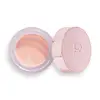What's inside
What's inside
 Key Ingredients
Key Ingredients

 Benefits
Benefits

 Concerns
Concerns

 Ingredients Side-by-side
Ingredients Side-by-side

Water
Skin ConditioningDimethicone
EmollientC13-14 Alkane
SolventPhenyl Trimethicone
Skin ConditioningGlycerin
HumectantButylene Glycol
HumectantDiethylhexyl Carbonate
EmollientCetyl PEG/PPG-10/1 Dimethicone
EmulsifyingPentylene Glycol
Skin ConditioningMica
Cosmetic ColorantPhenoxyethanol
PreservativeEthylhexylglycerin
Skin ConditioningTocopherol
AntioxidantMagnesium Sulfate
Triethoxycaprylylsilane
Disteardimonium Hectorite
StabilisingSorbitan Sesquioleate
EmulsifyingPentaerythrityl Tetra-Di-T-Butyl Hydroxyhydrocinnamate
AntioxidantSilica
AbrasiveVinyl Dimethicone/Methicone Silsesquioxane Crosspolymer
Stearoyl Inulin
EmollientDimethicone/Vinyl Dimethicone Crosspolymer
Skin ConditioningTrimethylsiloxysilicate
EmollientDisodium EDTA
Caffeine
Skin ConditioningSodium Hyaluronate
HumectantNiacinamide
Smoothing3-O-Ethyl Ascorbic Acid
Skin ConditioningCurcuma Longa Root Extract
MaskingCollagen
MoisturisingLeuconostoc/Radish Root Ferment Filtrate
AntimicrobialPanax Ginseng Root Extract
EmollientCitrus Aurantium Dulcis Fruit Extract
MaskingCitrus Aurantium Dulcis Flower Extract
Skin ConditioningEthyl Hexanediol
Solvent1,2-Hexanediol
Skin ConditioningCI 77891
Cosmetic ColorantCI 77491
Cosmetic ColorantWater, Dimethicone, C13-14 Alkane, Phenyl Trimethicone, Glycerin, Butylene Glycol, Diethylhexyl Carbonate, Cetyl PEG/PPG-10/1 Dimethicone, Pentylene Glycol, Mica, Phenoxyethanol, Ethylhexylglycerin, Tocopherol, Magnesium Sulfate, Triethoxycaprylylsilane, Disteardimonium Hectorite, Sorbitan Sesquioleate, Pentaerythrityl Tetra-Di-T-Butyl Hydroxyhydrocinnamate, Silica, Vinyl Dimethicone/Methicone Silsesquioxane Crosspolymer, Stearoyl Inulin, Dimethicone/Vinyl Dimethicone Crosspolymer, Trimethylsiloxysilicate, Disodium EDTA, Caffeine, Sodium Hyaluronate, Niacinamide, 3-O-Ethyl Ascorbic Acid, Curcuma Longa Root Extract, Collagen, Leuconostoc/Radish Root Ferment Filtrate, Panax Ginseng Root Extract, Citrus Aurantium Dulcis Fruit Extract, Citrus Aurantium Dulcis Flower Extract, Ethyl Hexanediol, 1,2-Hexanediol, CI 77891, CI 77491
Paraffinum Liquidum
EmollientPolyisobutene
Hydrogenated Polyisobutene
EmollientPentaerythrityl Tetraisostearate
EmollientHydrogenated Microcrystalline Wax
Emulsion StabilisingPolyglyceryl-3 Diisostearate
EmulsifyingBis-Diglyceryl Polyacyladipate-2
EmollientSilica
AbrasiveParaffin
PerfumingGlyceryl Stearate Se
EmulsifyingCera Microcristallina
Emulsion StabilisingPhenoxyethanol
PreservativeSimmondsia Chinensis Seed Oil
EmollientVitis Vinifera Seed Oil
EmollientTocopheryl Acetate
AntioxidantTocopherol
AntioxidantBHT
AntioxidantCI 77891
Cosmetic ColorantCI 77499
Cosmetic ColorantCI 77491
Cosmetic ColorantCI 77492
Cosmetic ColorantParaffinum Liquidum, Polyisobutene, Hydrogenated Polyisobutene, Pentaerythrityl Tetraisostearate, Hydrogenated Microcrystalline Wax, Polyglyceryl-3 Diisostearate, Bis-Diglyceryl Polyacyladipate-2, Silica, Paraffin, Glyceryl Stearate Se, Cera Microcristallina, Phenoxyethanol, Simmondsia Chinensis Seed Oil, Vitis Vinifera Seed Oil, Tocopheryl Acetate, Tocopherol, BHT, CI 77891, CI 77499, CI 77491, CI 77492
Ingredients Explained
These ingredients are found in both products.
Ingredients higher up in an ingredient list are typically present in a larger amount.
Ci 77491 is also hydrated iron III oxide. It's sole purpose is to give a red/pink hue to products.
Iron III oxides are classified as inorganic chemicals for coloring.
Synthetically created Ci 77491 is considered safer than those naturally found. This is because the synthetically created version may contain less impurities. Iron oxides are generally non-toxic and non-allergenic.
Learn more about CI 77491Ci 77891 is a white pigment from Titanium dioxide. It is naturally found in minerals such as rutile and ilmenite.
It's main function is to add a white color to cosmetics. It can also be mixed with other colors to create different shades.
Ci 77891 is commonly found in sunscreens due to its ability to block UV rays.
Learn more about CI 77891Phenoxyethanol is a preservative that has germicide, antimicrobial, and aromatic properties. Studies show that phenoxyethanol can prevent microbial growth. By itself, it has a scent that is similar to that of a rose.
It's often used in formulations along with Caprylyl Glycol to preserve the shelf life of products.
Silica, also known as silicon dioxide, is a naturally occurring mineral. It is used as a fine, spherical, and porous powder in cosmetics.
Though it has exfoliant properties, the function of silica varies depending on the product.
The unique structure of silica enhances the spreadability and adds smoothness, making it a great texture enhancer.
It is also used as an active carrier, emulsifier, and mattifier due to its ability to absorb excess oil.
In some products, tiny microneedles called spicules are made from silica or hydrolyzed sponge. When you rub them in, they lightly polish away dead skin layers and enhance the penetration of active ingredients.
Learn more about SilicaTocopherol (also known as Vitamin E) is a common antioxidant used to help protect the skin from free-radicals and strengthen the skin barrier. It's also fat soluble - this means our skin is great at absorbing it.
Vitamin E also helps keep your natural skin lipids healthy. Your lipid skin barrier naturally consists of lipids, ceramides, and fatty acids. Vitamin E offers extra protection for your skin’s lipid barrier, keeping your skin healthy and nourished.
Another benefit is a bit of UV protection. Vitamin E helps reduce the damage caused by UVB rays. (It should not replace your sunscreen). Combining it with Vitamin C can decrease sunburned cells and hyperpigmentation after UV exposure.
You might have noticed Vitamin E + C often paired together. This is because it is great at stabilizing Vitamin C. Using the two together helps increase the effectiveness of both ingredients.
There are often claims that Vitamin E can reduce/prevent scarring, but these claims haven't been confirmed by scientific research.
Learn more about Tocopherol